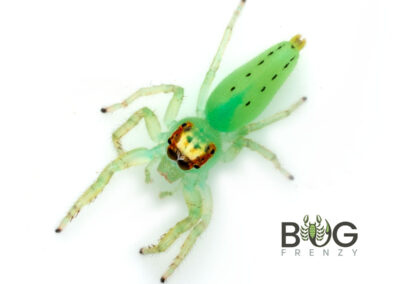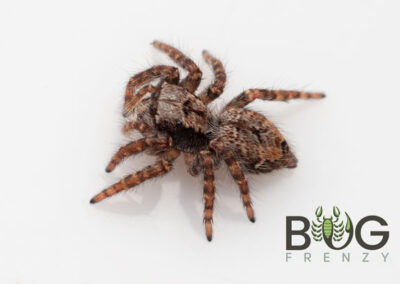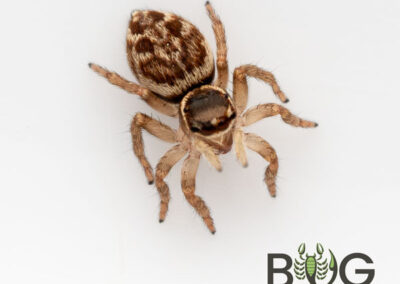Keeping a Pet Jumping Spider
The best thing you’ll ever do 😉
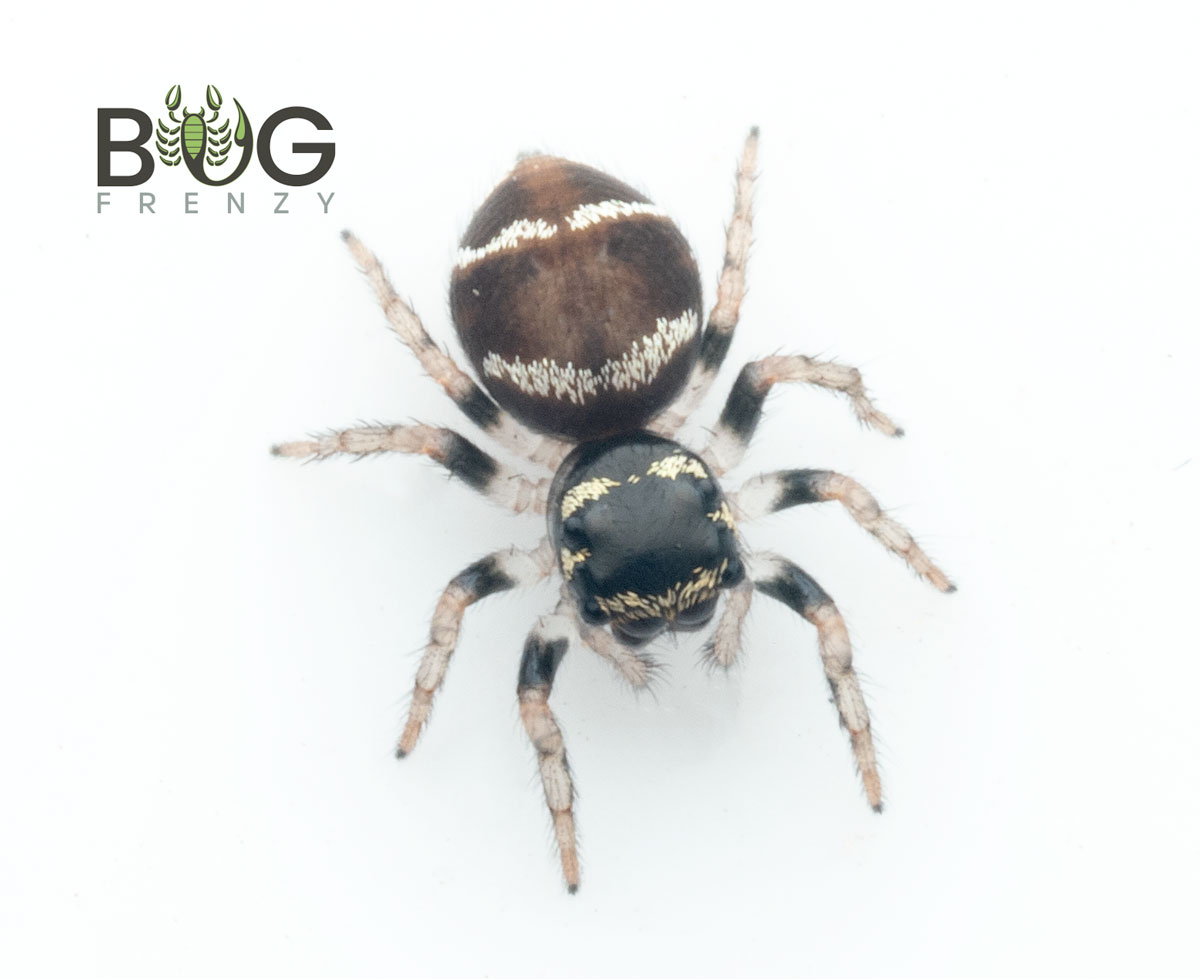
Welcome to the wonderful world of pet jumping spiders!
Here at Bug Frenzy we love all jumping spiders – from tiny colourful peacocks to big and friendly Giant Bark jumping spiders.
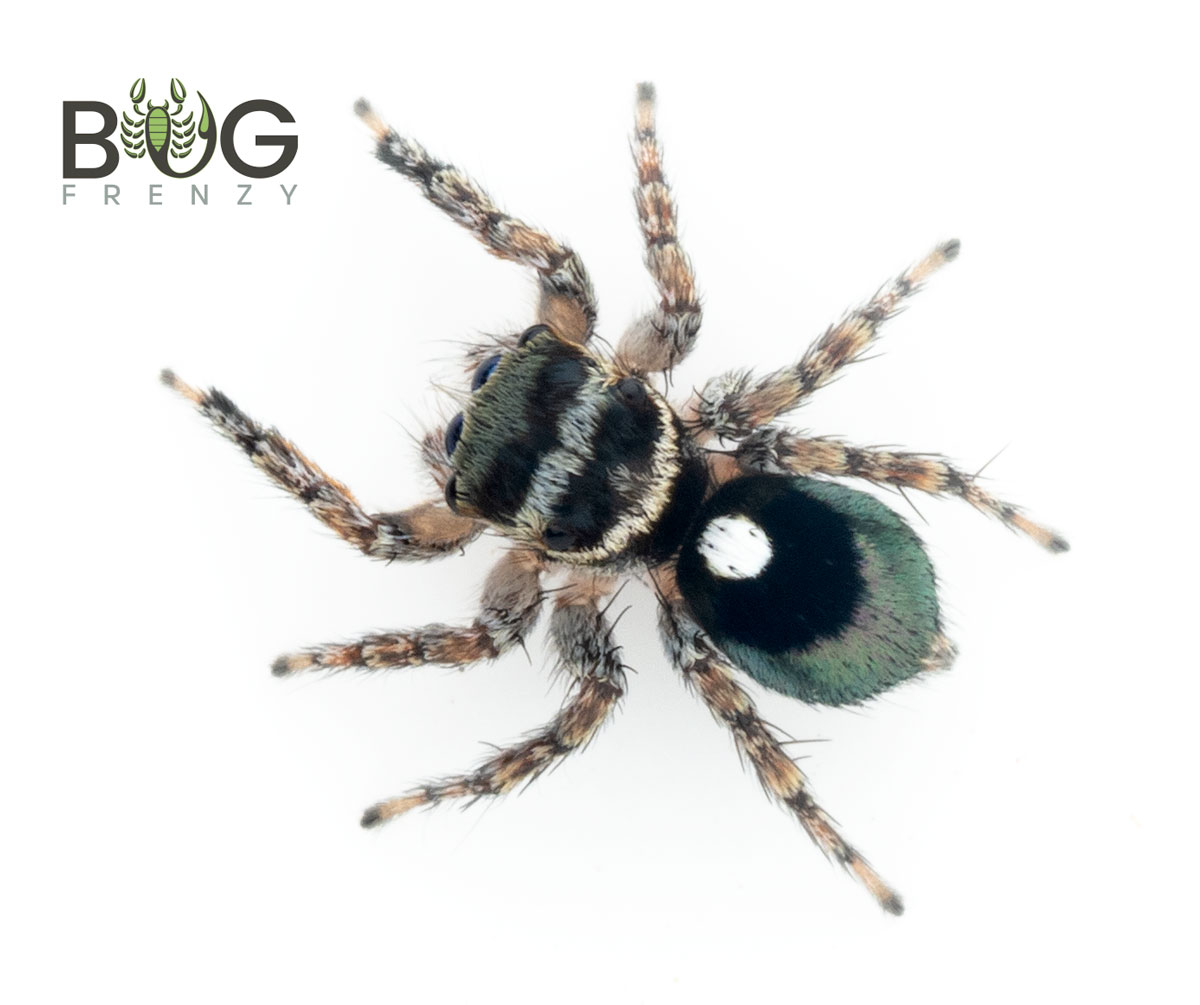
If you have ever thought of getting a jumper as a pet, you have come to the right place!
Our extensive guide to keeping your very own jumper starts here.
Alright, let’s get started!
Choosing the perfect jumper
If you are a beginner you want to start with one of our bigger species of jumpers. Species like:
- Giant Bark Jumping Spider (Servaea incana)
- Giant Green Jumping spider (Mopsus mormon)
- Opisthoncus sp. (Prince/Princess/Bridal)
- Red headed hopper (Maratus griseus)
- Slender Giant Bark (Helpis sp)
These jumpers, along with some other bigger species make excellent beginner pets because they are hardy, easy to care for, friendly and great to observe.
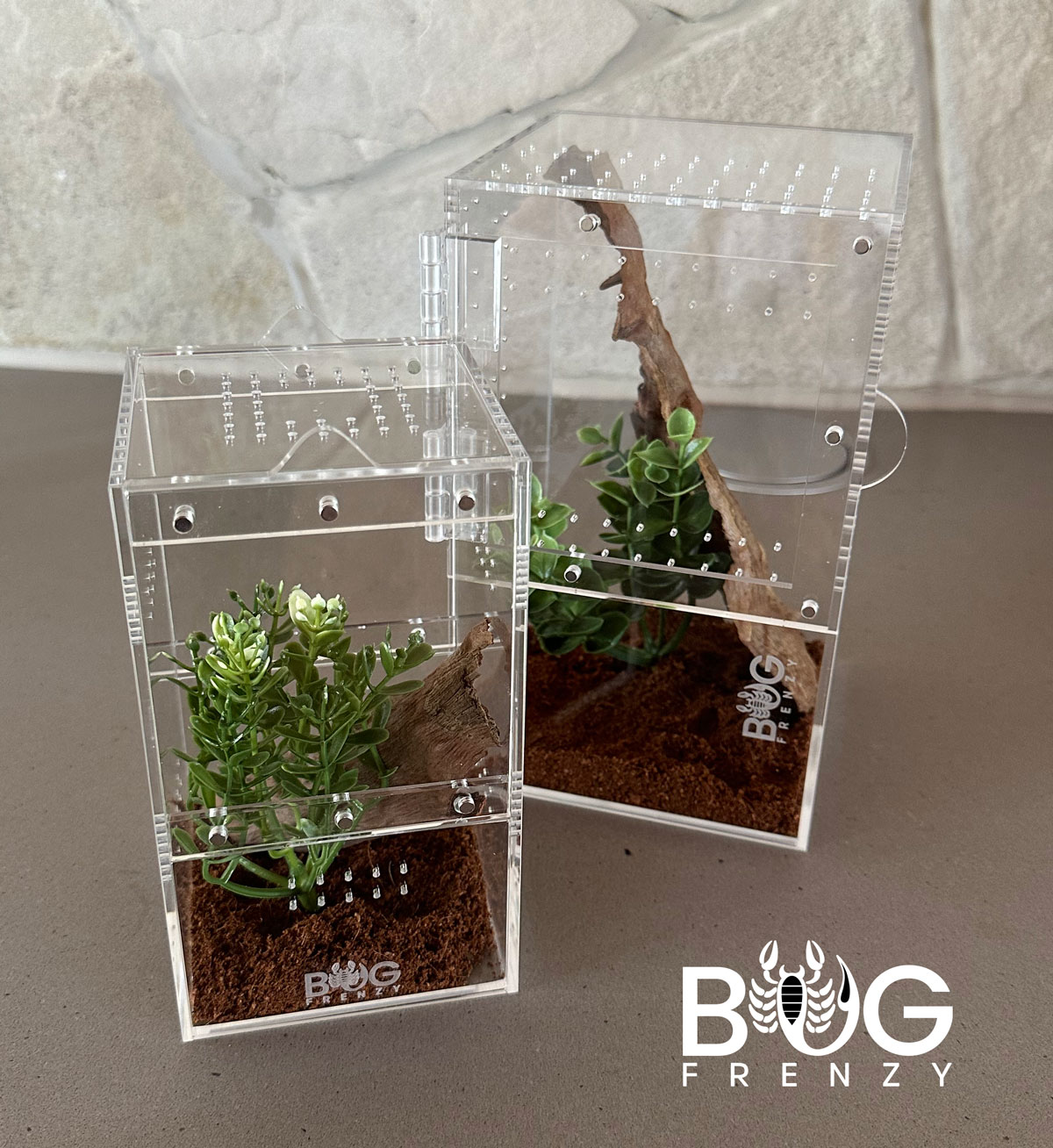
Feeding your spider
Your spider will need to eat crickets. We offer our jumpers 3 crickets every 3 days, giving them the opportunity to eat a cricket every day. We also take the opportunity to lightly mist the side of the enclosure with some water, using a spray bottle.
Do not catch and feed your jumper wild flying or crawling insects to eat. There is a high risk that these insects around your house has residue insecticides on their wings and could posion your jumper in the process.
Some jumpers have specialised diets such as only eating other spiders (like a Portia jumping spider) but we do not sell these jumpers. When you buy a jumper from us you can know with confidence that your spider is perfectly happy to eat crickets.
What size cricket should I feed my jumping spider?
As a rule the cricket should never be bigger than the jumper. If you look at the picture provided you will see we recommend a cricket that is about a third to half of the spider’s body size.
If you spider seem scared of the prey and runs away from it, it is most likely too big. If your spiders shows no interest in the cricket, then it could be too small.
OK, what will I need?
Well, your new little friend will need a safe place to live. So you will need an enclosure. What should your enclosure look like?
– It should be at least 8x8x8cm or bigger.
– It should have some ventilation holes that is not too big for the spider to escape through.
– It should preferably have a side opening door to prevent disturbing the spider’s sleeping web (hammock) when you open the door.
– You should provide some substrate, some fake plants and perhaps a bark hide.
– A water bowl is not recommended to ensure the spider does not accidentally drown. Instead we recommend you lightly mist the one side of the enclosure once or twice a week.
And… then you will need food for your jumping spider in the form of appropriate sized crickets.
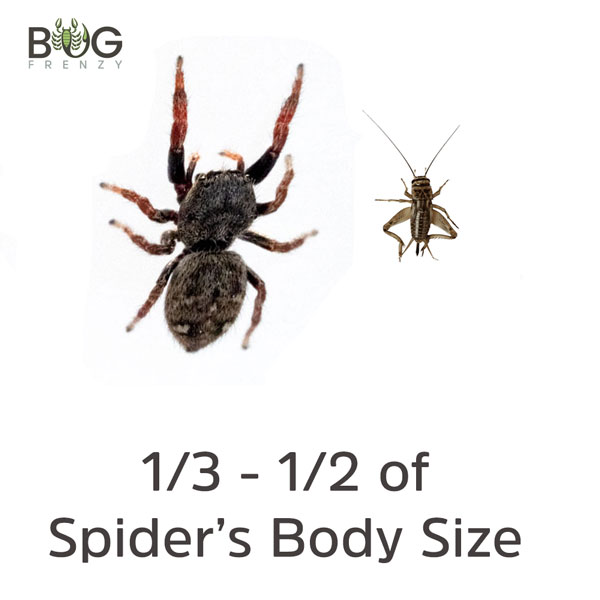
Sleeping Arrangements
The majority of jumping spiders will construct a sleeping web or hammock – usually at the top of the enclosure, or between two leaves, or behind a piece of bark. They will spend the whole night and part of the day inside their hammock, for a bit of “me-time”.
It is very important that you do not disturb your spider for any reason whatsoever when he is in his hammock. The hammock provides protection for when your spider needs to moult by shedding it’s exoskeleton. This process can take a couple of minutes to a couple of hours, but the spider will most likely spend a lot more time in the hammock during this process – sometimes staying in there for up to 3 weeks.
It is very tempting to poke and disturb the spider to see if he is still alive and well, but please do not. Your spider needs time for his new exoskeleton to harden up before he will come out again looking for food. When he is out and about again, you may go ahead and feed him. If he has made his hammock on the lid and you cannot open it without breaking the web, then you’ll simply have to wait for the spider to emerge out of the web again before attemping to open the enclosure. Do not disturn the spider under any circumstance when it is in a web.
Some jumping spiders do not make hammocks, but burrows in the substrate instead. Our beach peacocks, beach pebble jumping spiders and some other species likes to build a little silk bubble under the sand in which they spend most of their time in. It can be quite alarming if you think your spider has dissapeared from its enclosure just to realise that the little bugger is sleeping his head off in a silk bubble just under the surface of the sand!
Lighting and Heating
Your spider needs to see it’s prey in the day. They depend on their excellent eye sight to catch their prey and therefor should never be kept in a dark room or a dark corner where they cannot see properly. Their live depends on it.
Your spider does not need any heating. If you have bought a jumper from a tropical area such as Far North QLD and you live in Melbourne, just make sure you keep the spider in a room where the temperature does not drop below 10 degrees celsius. However, do not, and I repeat again, do not put the enclosure near any kind of heater or heatpad. Also never directly in any sunlight. This will surely lead to your spider dying by overheating or drying out.
My jumper has laid an egg sack, what now?
If you are the proud owner of a wild caught adult female jumper there could be chance that your lady is indeed gravid. Spiders can store sperm for a long time and only need to mate once to lay several eggsacks.
However, if you had your jumper since it was a juvenile or is one of our captive bred jumpers, then the egg sack is not fertile and you do not need to worry about being a brand new spider grandparent.
You have three options on how to proceed from this point onwards.
- If your jumper is found naturally in your area of residence, you can safely release the babies once they disperse into your garden and they will be able to hunt for their own food and with some good luck, grow up to a healthy adult.
- You can decide to raise the babies yourself (more on this below)
- If your jumper is not native to your area or you are not up to the task of raising it, please contact us and we can arrange to take the babies off your hands and raise them here at Bug Frenzy.
Ok, if you chose option 2, this is what you will need to do:
The egg sack will usually be heavily protected inside a thick hammock and guarded by mum for 3-5 weeks. You may be able to see the eggs and count them, giving you an idea of how many babies you will need to raise.
The little babies will hatch and stay in the hammock for at least another week or two. This is called first instar and they are essentially eggs with legs. Once they molt again, they will start to leave the nest when they are ready to eat and become self-sufficient. This stage is called second instar.
You will need to make sure you have ordered a culture of flightless fruit flies as soon as you see the babies hatching. Once they emerge from the nest in about two weeks time, you will need to seperate them into deli cups and start feeding them a flightless fruit fly every day/every other day.
They do not need any ventilation holes at this stage as they will probably be small enough to escape through them. A tiny water drop once a week will be sufficient for their hydration needs as they get what they need from their food.
If the baby jumper makes a hammock and stays in there for an extended period of time it is most likely molting and you should not disturb it. Disturbing it or poking the hammock can cause death. The jumper will be at its most vulnerable during this stage and that is why it is important to leave it alone at all cost. Once it emerges again you may continue the feeding routine.
Once the jumper reaches 5th instar it should be big enough to start eating crickets. You will need to introduce the crickets one at a time, making sure it is an appropriate size – about a third to half the size of the jumper. Offering crickets bigger than the jumper may cause them harm, as crickets can be vicious.
If you have any questions please feel free to contact us at any time – always happy to help.
Frequently Asked Questions
Do you sell Regal Jumping Spiders?
No. Regal jumping spiders are a North American species and you cannot import them into Australia. We only sell native Australian species.
Are your jumpers captive bred?
We have several species of jumping spiders that we breed here at Bug Frenzy including Maratus griseus, Giant barks, some WA peacocks, Mopsus mormon just to name a few. We advertise these under our “Captive Bred Jumpers” section when they are available. We also sell some ethically collected species, which we collect ourselves to ensure that it is done in a responsible way – never taking jumpers in large numbers or from the same area. We also have a repopulation program where we release captive bred babies back into the wild from where the parents came from to help with repopulation.
My local petshop is fresh out of crickets what should I do?
I know it is tempting to go and catch a few flies or moths from the verandah to feed to your jumping spider, but please do not. Most flying and crawling insects you will find in and around your home has most likely residue pesticides on their wings. Your spider may be poisoned if you feed it to them. If your local pet shop can’t order the correct size crickets for you, contact us and we will see if we can make a plan to send you some of ours. Another alternative plan is to always have a fruit fly culture on hand that could provide emergency food for your spider while you source the right sized crickets. Or, look online if there is any shops that will send you some crickets via express.
Can I keep two or more jumpers together in the same enclosure?
No, not even if they are the same species. Jumpers are solitary creatures who would most likely eat each other given half a chance. You could house a female and male of the same species together if they are both mature adults, but even then you run the risk of one eating the other, so avoid it if you can.


